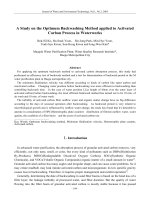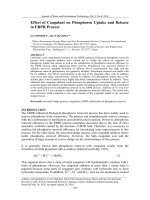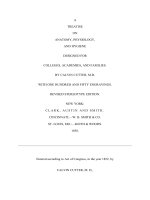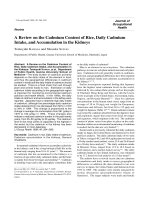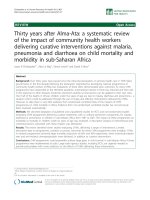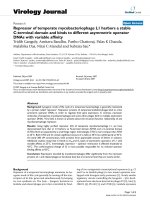A review on sample preparation and chromatographic determination of acephate and methamidophos in different samples
Bạn đang xem bản rút gọn của tài liệu. Xem và tải ngay bản đầy đủ của tài liệu tại đây (536.19 KB, 8 trang )
REVIEW
A review on sample preparation
and chromatographic determination of acephate
and methamidophos in different samples
Vijay Kumar
a
, Niraj Upadhyay
b,
*
, Virender Kumar
a
, Sitansh Sharma
a
a
Department of Chemistry, Lovely Professional University, Punjab, India
b
Department of Chemistry, Dr. Hari Singh Gour University, Sagar, Madhya Pradesh, India
Received 22 January 2014; accepted 27 December 2014
Available online 3 January 2015
KEYWORDS
Acephate;
Methamidophos;
Toxicity;
Biological decomposition;
Methods of detection
Abstract Acephate and its metabolite methamidophos are common organophosphorus insecticide
used for crop protection. High uses of acephate and methamidophos have induced health issues and
environmental pollution. Their undesired presence in the environment is creating ecotoxicology and
may harm human health. It is therefore essential to detect the presence of acephate and methami-
dophos even in trace level. In this review, we have tried to accommodate successful methods of
detection of acephate and methamidophos in the different biological media. Their recovery and res-
idue analysis in different media such as vegetables, human and animal tissues have also included.
The most common method for their determination is based on chromatographic separation and
identification. Among different chromatographic methods, LC and GC coupled with different
detectors have used. But, they both need extensive pretreatment and cleanup procedure, before
undergoing chromatographic separation and identification. LC coupled with mass spectrometry
(LCMS) is sometime able to detect acephate and methamidophos in ppm level.
ª 2015 The Authors. Production and hosting by Elsevier B.V. on behalf of King Saud University. This is an
open access article under the CC BY-NC-ND license ( />Contents
1. Introduction . . . . . . . . . . . . . . . . . . . . . . . . . . . . . . . . . . . . . . . . . . . . . . . . . . . . . . . . . . . . . . . . . . . . . . . . . . . 625
2. Mode of action and toxicity . . . . . . . . . . . . . . . . . . . . . . . . . . . . . . . . . . . . . . . . . . . . . . . . . . . . . . . . . . . . . . . . 625
3. Detection of acephate and methamidophos . . . . . . . . . . . . . . . . . . . . . . . . . . . . . . . . . . . . . . . . . . . . . . . . . . . . . 626
*
Corresponding author.
E-mail address: (N. Upadhyay).
Peer review under responsibility of King Saud University.
Production and hosting by Elsevier
Arabian Journal of Chemistry (2015) 8, 624–631
King Saud University
Arabian Journal of Chemistry
www.ksu.edu.sa
www.sciencedirect.com
/>1878-5352 ª 2015 The Authors. Production and hosting by Elsevier B.V. on behalf of King Saud University.
This is an open access article under the CC BY-NC-ND license ( />4. Pretreatment procedure . . . . . . . . . . . . . . . . . . . . . . . . . . . . . . . . . . . . . . . . . . . . . . . . . . . . . . . . . . . . . . . . . . . 627
4.1. Determination of acephate and methamidophos in serum and blood . . . . . . . . . . . . . . . . . . . . . . . . . . . . . . . . 627
4.2. Determination of acephate and methamidophos in human and animal urine . . . . . . . . . . . . . . . . . . . . . . . . . . 628
4.3. Determination of acephate and methamidophos in vegetables . . . . . . . . . . . . . . . . . . . . . . . . . . . . . . . . . . . . . 628
4.4. Determination of acephate and methamidophos in soils and waters. . . . . . . . . . . . . . . . . . . . . . . . . . . . . . . . . 629
5. Conclusion . . . . . . . . . . . . . . . . . . . . . . . . . . . . . . . . . . . . . . . . . . . . . . . . . . . . . . . . . . . . . . . . . . . . . . . . . . . . 629
References . . . . . . . . . . . . . . . . . . . . . . . . . . . . . . . . . . . . . . . . . . . . . . . . . . . . . . . . . . . . . . . . . . . . . . . . . . . . 629
1. Introduction
Acephate (O,S-Dimethyl acetylphosphoramidothioate) (Table.
1) is an organophosphate insecticide, introduced by Chevron
Chemical in 1971 (Magee, 1973) and first time registered for
use by the United States Environmental Protection Agency
in 1973. It has been observed that the production of acephate
increased quickly from last 5 years, surprisingly in India, 10%
increase in production of technical grade was observed within
one year (Standing Committee on Chemicals & Fertilizers,
2012-13).
It is an insecticide registered for use on food crops, agricul-
tural seed and non-bearing plants, institutions and commercial
buildings including public health facilities, sod, golf course
turf, ant mounds, and horticultural nursery plants.
In soil, plants and insects approximate half-life period of
acephate is 3–6 days, although in some soils the half-life may
be increased to more than 13–60 days due to variation of prop-
erties (physical, chemical and biological) of soils (Antonious
and Snyder, 1994; Bouchard and Lavy, 1982; Chuanjiang
et al., 2010; Yen et al., 2000). Acidic nature of soil is responsible
for long life spam of acephate in soils ((Antonious and Snyder,
1994; Bouchard and Lavy, 1982; Chuanjiang et al., 2010). It has
been observed that, after the decomposition acephate generally
converts into highly toxic methamidophos (O,S-dimethyl
phosphoramidothioate) (Table 1) and methamidophos is also
an efficient organophosphorus insecticide (Yen et al., 2000;
Chuckwudebe, 1984). Methamidophos is the major metabolite
of acephate. It is toxic, not only for insects but also in various
components of the environment such as nontarget animals,
plants, waters, and soils (Wang et al., 2013) (see Tables 2–4).
Physicochemical properties of acephate and methamido-
phos are signifying that both are hydrophilic and having low
soil sorption with an order acephate > methamidophos
(Roberts & Hutson, 1999; Tomlin, 2006). Consequently, their
runoff through water medium can produce potential water
contamination (Roberts & Hutson, 1999; Tomlin, 2006). Ace-
phate leads to contamination of groundwater much more read-
ily than methamidophos under normal environmental
conditions. Studies highlight that wet soils are more conducive
for the contamination of the aquatic environment with ace-
phate and its metabolites (Chai et al., 2009; Wang et al., 2013).
2. Mode of action and toxicity
Acephate and methamidophos inhibit acetylcholinesterase
enzyme (AChE) in nervous system tissues, although, ace-
phate itself is a weak acetylcholinesterase inhibitor as com-
pared to its decomposed product methamidophos (Wilson
et al., 1990; Spassova et al., 2000). The toxicity of acephate
and methamidophos varies with application of enantiomeric
compound of them (Wang et al., 2013). Both acephate and
its metabolite methamidophos have the stereogenic phospho-
rus atom. The enantioselective bioactivity of enantiomers of
acephate and methamidophos has been observed during past
years. The R-(+)-enantiomers of acephate and methamido-
phos were found to be more potent to houseflies than the
optical antipodes and racemates, whereas the S-(À)-enantio-
mers were more toxic for German cockroaches soils
(Miyazaki et al., 1988; Wang et al., 2006, 2013). Another
experiment showed that (À)-methamidophos was about
8.0À12.4 times more potent to the bovine erythrocytes and
Electrophorus electricus than its (+)-form, but the (+)-
enantiomer was 7.0 times more toxic to D. magna in 48 h
tests (Lin et al., 2006). It was also concluded that D-(+)-
methamidophos should be responsible for the organophos-
phate-induced delayed poly-neuropathy when racemic meth-
amidophos is given to hens (Lotti et al., 1995).
Acephate and methamidophos are extremely toxic to aqua-
tic invertebrates, birds and mammals (Tomlin, 2006; Vyas
et al., 1996; Mahajna et al., 1997). The most likely route of
exposure to acephate and methamidophos for the public is
Table 1 Chemical structure and physicochemical properties of acephate and methamidophos (Roberts & Hutson, 1999; Tomlin,
2006).
Name Chemical structure Molecular weight (g/mol) Solubility g/L Log K
OW
Henry’s law constant (atm m
3
/mol)
Acephate
183.16 790 in water at 25 °C 0.13 at 25 °C 5.1 · 10
À13
at 25 °C
Methamidophos
141.13 200 in water at 25 °C À0.65 at 25 °C 8.64 · 10
À10
at 25 °C
A review on sample preparation and chromatographic determination 625
via residues in food (WHO, 2003, 2005). The prolonged or
continued use of acephate and methamidophos in plant protec-
tion may lead to significant dermal exposure with an impact on
cholinesterase, genotoxicity and cardiotoxicity activities
(Farag et al., 2000;Spassova et al., 2000; Padungtod et al.,
1998).
Immense toxicity of acephate and methamidophos has been
observed in environment including birds (Zinkl et al., 1981;
Vyas et al., 1996), animals (Singh and Drewes, 1987), fishes
(Szeto et al., 1979), soils and its microorganisms (Wu et al.,
2010; Lo, 2010; Battu et al., 2009). Studies have revealed that
acephate and methamidophos can persist on soils (Zhang
et al., 2005; Battu et al., 2009), fruits and vegetables
(Antonious and Snyder, 1994; Bouchard and Lavy, 1982;
Chuanjiang et al., 2010; Zhang et al., 2008), in dietary products
(WHO, 2003, 2005; Nougade
`
re et al., 2012), cereal and other
cash crops (Hiemstra & Kok, 2007; Antonious and Snyder,
1994; Bouchard and Lavy, 1982; Chuanjiang et al., 2010).
Both, acephate and methamidophos having high leaching
capacity, contaminate agriculture soils by leaching behavior
(Chai et al., 2009, 2010). Studies have revealed that the concen-
trations of acephate and methamidophos in the rat tissues vary
from 0.2 to 1.1 ppm. The highest concentrations were found in
kidney (4.1–12 ppm), testes (2.4–3.9 ppm) and brain (2.1–
2.5 ppm). There was no tendency for methamidophos to accu-
mulate in blood, liver, muscle, fat or heart (Farag et al., 2000;
Spassova et al., 2000; Padungtod et al., 1998; WHO, 2003,
2005). But, acephate and methamidophos are found highly
toxic to bees and other beneficial insects. The LD
50
for ace-
phate was 1.2 lg/honeybee. The LD
50
of methamidophos
was 1.37 lg/honeybee (EPA, 2006). Exposure of acephate
and methamidophos was checked on farmers by Maroni
et al. (1990), acephate was detected in urine, red blood cell
(RBC) and milk, but methamidophos was in minute amount.
Daily maximum acephate urine concentrations range was
found from 3 to 9 mg/L. Urinary concentration of acephate
was non-detectable after 48 h of the exposure (Maroni et al.,
1990).
3. Detection of acephate and methamidophos
Based on physicochemical properties of acephate and metham-
idophos, most of the researchers decided to use chromato-
graphic technique for the detection of acephate and
methamidophos. Because of low molecular mass, gas chroma-
tography (GC) coupled with different detectors has been used
Table 4 Recovery data (%) for acephate and methamidophos
in the matrix: lettuce, orange, apple, cabbage, grape and wheat
flour respectively.
Matrix Acephate Methamidophos
Recovery (%) RSD Recovery (%) RSD
Lettuce 81 11 93 11
Orange 95 5 77 11
Apple 84 5 70 7
Cabbage 81 7 83 5
Grape 85 9 78 8
Wheat flour 75 6 70 11
Table 2 Toxicity of acephate in biological media.
Mammals Aquatic organisms Plants
Rat –LD
50
866 mg/kg, oral, and LC
50
> 15 mg/m
3
(1 h), inhalation
Goldfish –EC
50
9550 mg/l for 96 h. Corn – > 30% effect at 4.5 kg/ha.
Wheat – 15–40% effect at 4.3 mg/l
Dog –LD
50
210 mg/kg, oral Rainbow trout –LC
50
1000 mg/l (96 h) Lettuce – > 40% effect at 0.5 kg/ha
Mouse –LD
50
360 mg/kg, oral Perch – LC
50
16 mg/l (96 h) Millet – 15–40% effect at 1.6 mg/l
Rabbit –LD
50
> 10,000 mg/kg, oral and 7500 mg/kg, dermal Bluegill –LC
50
> 1000 mg/l (96 h) Soybean – 15–40% effect at 1.1 mg/l
Table 3 Analytical techniques for determination of acephate and methamidophos in different media.
Authors Technique Medium Metabolite Extraction Techniques
Araoud et al. (2010) Liquid chromatography
tandem mass spectrometry
Human blood Acephate methamidophos,
etc.
Liquid–liquid extraction
Khan et al. (2010) HPLC and GC with NPD
detector
Plasma alanine
aminotransferase, aspartate
aminotransferase, creatinine,
urea, and gamma
glutamyltransferase
Methamidophos, etc. Liquid–liquid extraction
Tanaka et al. (2005) Liquid chromatography
mass spectrometry
Human serum
pseudocholinesterase
Acephate and
methamidophos
Liquid–liquid extraction
Ueyama et al. (2006) Gas chromatography mass
spectrometry
Human and animal urine Multiresidue including
acephate and methamidophos
Liquid–solid phase
extraction
Hardt and Angerer
(2000)
Gas chromatography mass
spectrometry
Human and animal urine Multiresidue including
acephate and methamidophos
Liquid–liquid phase
extraction
(Agu
¨
era et al., 2002 Tandem mass
spectrometry
Vegetables and fruits Multiresidue including
acephate and methamidophos
Liquid–solid phase
extraction
Zhang et al. (2002) Gas chromatography with
flame photometric detection
Water, soil and plants Multiresidue including
acephate and methamidophos
Liquid–solid phase
extraction
626 V. Kumar et al.
for analysis. Gas chromatography requires less pretreatment as
well as cleanup methods and shows low detection limit, but at
the same time needs derivatization of acephate/methamido-
phos. Because the high polarity reverse phase liquid chroma-
tography (RPLC) is a method of choice for the detection of
acephate and monocrotophos, it has merit of high degree of
selectivity and sensitivity. But, the method requires extensive
pretreatment and cleanup method(s). In addition, sometimes
methods are pH dependent and require use of buffer to inhibit
any change in pH. In this review, we propose analytical proce-
dures and materials used in the determination of the acephate
and methamidophos present in different sorbing media such as
vegetables, human and animal tissues, blood, serum, soils, etc.
Before going in detail about any method of detection, let us
first discuss about some of the pretreatment and cleanup
methods.
4. Pretreatment procedure
Real-world sample for analysis is always complex. In order to
get best result with low interference of unwanted substances,
pretreatment of the sample is the prime requirement. Because
of their high solubility in water, they (acephate and methami-
dophos) can reach to plant as well as non-target species
through absorption as well as adsorption processes. In order
to remove acephate and its degraded product from the com-
plex matrix various researchers have established different pre-
treatment methods.
In soil, acephate and its metabolites adsorb over silica or
alumina. For this purpose, the soil samples are collected in
the field, are air-dried, grounded and sieved through a mesh
with a grain size of 2 mm. This follows mostly liquid–solid
extraction technique (prominently Soxhlet based technique)
(Araoud et al., 2010; Montesano et al., 2007; Prasad et al.,
2013; Schindler et al., 2009). Because of the polarity factor
water or methanol is used as an extractant for acephate,
although in the more complex soil media other solvents are
also used such as, ethyl acetate, hexane, buffered water and
cyclohexane–acetone in ratio (1:1).
After pretreatment different cleanup methods have
employed to avoid interference with other organic motifs.
Depending on types of interference, different groups incorpo-
rated different sorbents for isolation of organic compounds
from the extracted solutions, including alumina, Florisil, ion-
exchange resins, silica gel/silica-based sorbents (e.g., octa-
decyl-, octyl-, phenyl-, and diol-bonded silica) and graphitized
black carbon (Araoud et al., 2010; Montesano et al., 2007;
Schindler et al., 2009). Whole procedure of extraction, cleanup
and sample loading is summarized in Fig. 1.
4.1. Determination of acephate and methamidophos in serum and
blood
Inoue et al. (1998) have determined ten organophosphorus pes-
ticides including acephate and methamidophos concentrations
in serum of acute poisoning patients by LCMS. In the reported
method, compounds are extracted in acetonitrile, evaporated to
0.5–0.9 mL, and allowed for liquid chromatographic mass spec-
troscopic (LCMS) analysis using methanol as mobile phase and
ammonium formate as a buffer. Studies have shown recovery in
serum over the range between 60.0% and 108.1%, the limits of
detection ranged from 0.125 to 1 lg/mL, and the limits of quan-
tification ranged from 0.25 to 1.25 lg/mL.
An analytical and multiple reactions monitoring method
for the determination of multiresidue of pesticides was devel-
oped including the acephate and methamidophos; method
involves a liquid–liquid extraction procedure followed by
liquid chromatography tandem mass spectrometry (LC–
TMS) for the identification and quantification of compounds.
Ionization of molecules was performed by the electrospray
Figure 1 Flow steps of extraction, cleanup and sample loading of organophosphate pesticides including acephate and its metabolites
with LC/GC–MS column. (Here, RT is room temperature; LC is liquid chromatography; GC is gas chromatography; and MS is mass).
A review on sample preparation and chromatographic determination 627
mode. The average recoveries obtained, at three different for-
tification levels, ranged between 65% and 106% for most of
the pesticides studied, except for methamidophos (lower than
25%). The linearity of the method was over the range of 5
to 50 lg/L with a correlation coefficient from 0.995 to 0.999,
depending on the analyte. The estimated limit of detection
and limit of quantification were 2 lg/L and 5 lg/L, respec-
tively (Araoud et al., 2010).
4.2. Determination of acephate and methamidophos in human
and animal urine
Acephate concentrations in the human urine were determined
by different researchers. Mostly, method includes dilution by
water and acetone, partitioned by acetone-methylene chloride
(1 + 1, v/v) after adjusting urine to neutral pH. After using
gas chromatography-pulsed flame photometric detection, limit
of detection was established at 2 lg/L and limit of quantitation
was 10 lg/L. The average recovery from urine fortified with
10–500 lg/L was 102 ± 12% (n = 32) (LePage et al., 2005;
Olsson et al., 2003). When the analysis of urinary samples
was done by LCMS method, the extraction efficiency ranged
between 52% and 63%, relative recoveries were about 100%,
and the limits of detection were over the range of 0.001–
0.282 ng/mL (Montesano et al., 2007).
It is equally typical to analyze polar pesticides in urine, so
their identification was done based on their stable metabolites.
In reported gas chromatographic-mass spectrometric method
(GCMS) (developed to check the metabolites of organophos-
phate pesticides including acephate and methamidophos), ana-
lytes were extracted from acidified urine into a mixture of
diethylether and acetonitrile, where dibutylphosphate used as
internal standard and derivatization is performed using penta-
fluorobenzylbromide at 40 °C overnight. After further liquid–
liquid extraction, analysis is carried out by gas chromatogra-
phy–mass spectrometry. The limits of detection were found
to be 5 lg/L urine for dimethylphosphate and 1 lg/L for the
other five metabolites, viz. diethylthiophosphate, O,O-dim-
ethyldithiophosphate, and O,O-diethyldithiophosphate in
human urine (Hardt and Angerer, 2000).
Another sensitive method namely gas chromatography–
mass spectrometry (GC–MS) was developed for the
simultaneous determination of urinary dialkylphosphates or
metabolites of organophosphorus insecticides including dim-
ethylphosphate (DMP), diethylphosphate (DEP), dimethyl-
thiophosphate (DMTP), and diethylthiophosphate (DETP),
using a pentafluorobenzylbromide derivatization. The limit
of determination was approximately found to be 0.3 lg/L for
DMP and 0.1 lg/L for each of DEP, DMTP, and DETP in
human urine (Ueyama et al., 2006). In the above mentioned
solid-phase extraction, derivatization was done with pentaflu-
orobenzyl bromide and further solid-phase cleanup done,
and the extracts were analyzed by gas chromatography–tan-
dem mass spectrometry. The limits of detection were 0.25 lg/
L for both analytes (Schindler et al., 2009).
4.3. Determination of acephate and methamidophos in vegetables
The observed residues of acephate and methamidophos have
found tremendous increase in their residues in year 2008 than
year 2006, as per the study that was done on Applesauce,
Bananas, Carrots, Cranberries, Eggplant, Grape, Green Col-
lard, Greens Kale, Orange Juice, Peaches, Plums, Potatoes,
Raisins, Spinach, Summer Squash, Sweet Peas, Frozen, Water-
melon and Winter Squash. Comparative study was done by
using chromatographic methods namely liquid or gas chroma-
tography–mass spectrometry, when 8515 samples were ana-
lyzed in year 2006 and 8686 samples in year 2008. Out of all
these samples, acephate was detected in 1.11% samples in year
2006, while 5.65% in year 2008. On the other hand, metham-
idophos was found in 1.02% samples of year 2006, which
increased to 4.89% in year 2008. Acephate and methamido-
phos were analyzed on spinach, summer squash, nectarines,
blueberries, collard greens, strawberries, and tomatoes
(PDPAS, 2006)(Fig. 2). A straightforward extraction method
based on liquid chromatography–mass spectrometry (LC–MS)
was reported; in which ethyl acetate was used as extractant and
0.1% acetic acid/water mixture was used as mobile phase with-
out undergoing any cleanup procedure. The method was vali-
dated at the 0.01 and 0.5 mg/kg level, for both cabbage and
grapes. Recoveries were reported in between 80% and 101%
with R.S.D. <11% (n = 5). The limit of quantification was
0.01 mg/kg and limit of detection was in between 0.001 and
0.004 mg/kg (Mol et al., 2003).
Another liquid chromatography-tandem quadrupole mass
spectrometry multi-residue method for the simultaneous target
analysis of a wide range of pesticides and metabolites in fruit,
vegetables and cereals (lettuce, orange, apple, cabbage, grape
and wheat flour, etc.) was reported by using acetone/dichloro-
methane/light petroleum as extraction solvents. As per report
recoveries ranged from 70% to 110%, with relative standard
deviations (RSD) better than 15%, were obtained (Hiemstra
and Kok, 2007). The observed values of recoveries and RSD
for acephate and methamidophos in lettuce, orange, apple,
cabbage, grape and wheat flour matrix are tabulated below
at fortification level 0.01 mg/kg (Hiemstra and Kok, 2007).
A gas chromatography (by using a combination of positive
chemical ionization and electron impact ionization modes)
tandem mass spectrometry method was employed for the anal-
ysis of organophosphates (including acephate and its metabo-
lites) in vegetables, the limits of detection obtained in a range
of 0.07 to 4.21 lg/kg. Average recoveries were in between 52%
and 114% while the RSD values greater than or equal to 29%
in all the cases were reported (Agu
¨
era et al, 2002). A simple,
fast and inexpensive, gas chromatography–mass spectrometry
method was introduced for the pesticide determination by sin-
gle-phase extraction of sample (10 g) with acetonitrile (10 mL),
followed by liquid–liquid partitioning after addition of 4 g
anhydrous MgSO
4
+ 1 g NaCl. Recoveries were obtained in
between 85% and 101% (mostly > 95%) and repeatabilities
typically < 5% were achieved for a wide range of fortified pes-
ticides (Anastassiades et al., 2003). Another GC based method
Figure 2 Study of acephate and methamidophos in food Grains
(PDPAS) during 2008 and 2006.
628 V. Kumar et al.
was developed for the sensitive determination of acephate and
other organophosphate pesticides by using 5% acetone in
hexane as extracting solvent and 1-chloro-4-fluorobenzene as
an internal standard in fruits and vegetables. The limit of
detection by the method was found in between 0.005 and
0.01 mg/kg and the limit of quantification was 0.01 mg/kg
(Lal et al., 2008).
4.4. Determination of acephate and methamidophos in soils and
waters
A gas chromatography with flame photometric detection
method was developed for the determination of concentrations
of organophosphate pesticides including acephate and meth-
amidophos in water, soil, sediment and plants. The concentra-
tions of the total organophosphate insecticides ranged from
92.77 to 229 ng/L in river water, 1.61 to 9.93 ng/g dry weights
in soil, 1.24 to 7.56 ng/g dry weights in sediment and 75.28 to
326 ng/g dry weights in plants were obtained by the researchers
(Zhang et al., 2002). An analytical methodology for the anal-
ysis of methamidophos in water and soil samples incorporating
a molecularly imprinted solid-phase extraction process using
methamidophos-imprinted polymer was developed, where the
confirmation of the imprinting done by FT-IR analysis due
hydrogen bonding between the COOH in the polymer cavities
and the NH
2
and P = O of the template is the origin of meth-
amidophos recognition. The use of molecularly imprinted
solid-phase extraction was found to improve the accuracy
and precision of the GC method and lowered the limit of
detection. The recovery of methamidophos extracted from
10.0 g soil sample at the 100 ng/g spike level was 95.4%. The
limit of detection was 3.8 ng/g. The recovery of methamido-
phos extracted from 100 mL tap and river water at 1 ng/mL
spike level was 96.1% and 95.8%, and the limits of detection
were 10 and 13 ng/L respectively (Kumar et al., 2013; Shen
et al., 2011).
5. Conclusion
The future perspective of the study is to check the decomposi-
tion of both acephate and its metabolite methamidophos in the
presence of different microorganisms, especially in plant
growth promoting bacteria. There is only one published infor-
mation available on microbial degradation of acephate by
Pseudomonas sp. Ind01, which uses acephate as a source of car-
bon to support cell growth and can promote the first step of
acephate mineralization in soil microbial communities. Also
there is information available on the microbial degradation
of methamidophos with species Hyphomicrobium species
MAP-1. However, in spite of the significant enantioselective
bioactivity of acephate and methamidophos, no present inves-
tigations on their environmental behavior have taken their chi-
rality into account. It should be recognized that the
enantiomers of acephate and its metabolite methamidophos
are independent entities which exhibit significant enantioselec-
tive bioactivity or toxicity to the target or nontarget organisms
as described above and may be transformed by microbes or
enzymes at different rates. Thus, information on the enantiose-
lective degradation and environmental behavior of parent ace-
phate as well as its metabolite methamidophos is essential to
evaluate the risk of these two chiral insecticides to human
and ecological health. This information cannot be obtained
from conventional achiral analysis. However, to our knowl-
edge, there was the only one published information available
on the transformation and degradation of the enantiomers of
acephate and its chiral metabolite methamidophos in soils
(Wang et al., 2013). Study highlighted that degradation of
racemates is enantioselective in unsterilized soils but not in
the sterilized soils, thus confirming that enantioselectivity is
microbial based. So there is a need to pay more attentions
on chirality based study of acephate and its metabolite meth-
amidophos on different soils under different conditions such
as temperature and pH.
Finally, we have concluded that acephate and methamido-
phos are distributed throughout the environment because of
its high water solubility and probable chances of water runoff.
Various methods have been reported to analyze level of ace-
phate and methamidophos in different media such as soil,
water, vegetable, serum, urine, etc. Most popular among them
is liquid chromatography mass spectrometry (LCMS) or gas
chromatography mass spectrometry (GCMS). But, LCMS
requires extensive pretreatment and cleanup procedure, while
GCMS needs derivatization of the compounds. The enantiose-
lective bioactivity of both acephate and methamidophos in
future may produce new method(s) of detection including deter-
mination of extent of toxicity of these pesticides. It is desirable
to develop new methods based on use of chromophores/fluoro-
phores which should be selective for acephate and its degraded
products. Because of high use of acephate and methamidophos
these days, their easy and fast analysis is also required. A lot of
scope for trend breaking research in this area is needed.
In biochemical aspects, decomposition pathway of
acephate with selected rhizobacteria in the presence of trace
and heavy metal ions, including the mechanisms is under
experimentation. Our future work will address the develop-
ment of spectrophotometric detection of acephate and its
metabolite.
References
Agu
¨
era, A., Contreras, M., Crespo, J., Ferna
´
ndez-Alba, A.R., 2002.
Multiresidue method for the analysis of multiclass pesticides in
agricultural products by gas chromatography–tandem mass spec-
trometry. Analyst 127 (3), 347–354
.
Anastassiades, M., Lehotay, S.J., Stajnbaher, D., Schenck, F.J., 2003.
Fast and easy multiresidue method employing acetonitrile extrac-
tion/partitioning and ‘‘dispersive solid-phase extraction’’ for the
determination of pesticide residues in produce. JAOAC Int. 86 (2),
412–431
.
Antonious, G.F., Snyder, J.C., 1994. Residues and half-lives of
acephate, methamidophos, and pirimiphos-methyl in leaves and
fruit of greenhouse grown tomatoes. Bull. Environ. Contam.
Toxicol. 52, 141–148
.
Araoud, M., Douki, W., Najjar, M.F., Kenani, A., 2010. A simple
analytical method for determination of pesticide residues in human
serum by liquid chromatography tandem mass spectrometry. J.
Environ. Sci. Health B 45 (3), 242–249
.
Battu, R., Sahoo, S., Jyot, G., 2009. Persistence of acephate and
cypermethrin oncotton leaves, cottonseed, lint and soil. Bull.
Environ. Contam. Toxicol. 82, 124–128
.
Bouchard, O.C., Lavy, T.L., 1982. Fate of acephate in the cotton
plant. J. Econ. Entomol. 75, 921–923
.
Chai, L.K., Mohd-Tahir, N., Bruun-Hansen, H.C., 2009. Dissipation
of acephate, chlorpyrifos, cypermethrin and their metabolites in a
A review on sample preparation and chromatographic determination 629
humid-tropical vegetable production system. Pest. Manage. Sci. 65
(2), 189–196.
Chai, L.K., Wong, M.H., Mohd-Tahir, N., Hansen, H.C.B., 2010.
Degradation and mineralization kinetics of acephate in humid
tropic soils of Malaysia. Chemosphere 79, 434–440.
Chuanjiang, T., Dahui, L., Xinzhong, Z., Shanshan, C., Lijuan, F.,
2010. Residue analysis of acephate and its metabolite methamido-
phos in open field and greenhouse pakchoi (Brassica campestris L.)
by gas chromatography-tandem mass spectrometry. Environ
Monit. Assess. 165, 685–692
.
Chuckwudebe, A.C., Hussain, M.A., Oloffs, P.C., 2000. Hydrolytic
and metabolic products of acephate. J. Environ. Sci. Health B 19
(6), 501–522.
Farag, A.T., Eweidah, M.H., El-Okazy, A.M., 2000. Reproductive
toxicology of acephate in male mice. Reprod. Toxicol. 14, 457–462.
Hardt, J., Angerer, J., 2000. Determination of dialkyl phosphates in
human urine using gas chromatography–mass spectrometry. J.
Anal. Toxicol. 24, 678–684
.
Hiemstra, M., de-Kok, A., 2007. Comprehensive multi-residue method
for the target analysis of pesticides in crops using liquid chroma-
tography–tandem mass spectrometry. J. Chromatogr. A 1154 (1–2),
3–25
.
Inoue, S., Saito, T., Mase, H., Suzuki, Y., Takazawa, K., Yamamoto,
I., Inokuchi, S., 2007. Rapid simultaneous determination for
organophosphorus pesticides in human serum by LC–MS. J.
Pharm. Biomed. Anal. 44 (1), 258–264
.
Khan, D.A., Hashmi, I., Mahjabeen, W., Naqvi, T.A., 2010. Moni-
toring health implications of pesticide exposure in factory workers
in Pakistan. Environ. Monit. Assess. 168, 231–240
.
Kumar, V., Upadhyay, N., Wasit, A.B., Singh, S., Kaur, P., 2013.
Spectroscopic methods for the detection of organophosphate
pesticides – a preview. Current World Environment. 8, 313–319.
Lal, A., Tan, G., Chai, M., 2008. Multiresidue analysis of pesticides in
fruits and vegetables using solid-phase extraction and gas chro-
matographic methods. Anal. Sci. 24 (2), 231–236.
LePage, J.T., Hebert, V.R., Tomaszewska, E.M., Rothlein, J.E.,
McCauley, L., 2005. Determination of acephate in human urine.
JAOAC Int. 88 (6), 1788–1792.
Lin, K., Zhou, S., Xu, C., Liu, W., 2006. Enantiomeric resolution and
biotoxicity of methamidophos. J. Agric. Food Chem. 54 (21), 8134–
8138
.
Lo, C.C., 2010. Effect of pesticides on soil microbial community. J.
Environ. Sci. Health B 45 (5), 348–359
.
Lotti, M., Moretto, A., Bertolazzi, M., Peraica, M., Fioroni, F., 1995.
Organophosphate polyneuropathy and neuropathy target esterase:
studies with methamidophos and its resolved optical isomers. Arch.
Toxicol. 69 (5), 330–336
.
Magee, P.S., 1973. N-Acyl derivatives of phosphoramidothioates.
U.S.Patent 3,716,600.
Mahajna, M., Quistad, G.B., Casida, J.E., 1997. Acephate insecticide
toxicity: safety conferred by inhibition of the bioactivating carb-
oxyamidase by the metabolite methamidophos. Chem. Res. Tox-
icol. 10, 64–69
.
Maroni, M., Catenacci, G., Galli, D., Cavallo, D., Ravazzani, G.,
1990. Biological monitoring of human exposure to acephate. Arch.
Environ. Contam. Toxicol. 19, 82–788.
Miyazaki, A., Nakamura, T., Kawaradani, M., Marumo, S., 1988.
Resolution and biological activity of both enantiomers of meth-
amidophos and acephate. J. Agric. Food Chem. 36 (4), 835–837
.
Mol, H.G., Van-Dam, R.C., Steijger, O.M., 2003. Determination of
polar organophosphorus pesticides in vegetables and fruits using
liquid chromatography with tandem mass spectrometry: selection
of extraction solvent. J. Chromatogr. A 1015, 119–127
.
Montesano, M.A., Olsson, A.O., Kuklenyik, P., Needham, L.L.,
Bradman, A.S., Barr, D.B., 2007. Method for determination of
acephate, methamidophos, omethoate, dimethoate, ethylenethiou-
rea and propylenethiourea in human urine using high-performance
liquid chromatographyatmospheric pressure chemical ionization
tandem mass spectrometry. J. Expo. Sci. Environ. Epidemiol. 17
(4), 321–330.
Nougade
`
re, A., Sirot, V., Kadar, A., Fastier, A., Truchot, E., Vergnet,
C., Hommet, F., Bayle
´
, J., Gros, P., Leblanc, J.C., 2012. Total diet
study on pesticide residues in France. Levels in food as consumed
and chronic dietary risk to consumers. Environ. Int. 45, 135–150
.
Olsson, A.O., Nguyen, J.V., Sadowski, M.A., Barr, D.B., 2003. A
liquid chromatography/electrospray ionization-tandem mass spec-
trometry method for quantification of specific organophosphorus
pesticide biomarkers in human urine. Anal. Bioanal. Chem. 376 (6),
808–815
.
Padungtod, C., Lasley, B.L., Christiani, D.C., Ryan, L.M., Xu, X.,
1998. Reproductive hormone profile among pesticide factory
workers. J. Occup. Environ. Med. 40 (12), 1038–1047
.
Pesticide Data Program Annual Summary (PDPAS), Calendar Year
2006; U.S. Department of Agriculture, Agricultural Marketing
Service. Washington, DC, 2007.
Prasad, R., Upadhyay, N., Kumar, V., 2013. Simultaneous determi-
nation of seven carbamate pesticide residues in gram, wheat, lentil,
soybean, fenugreek leaves and apple matrices. Microchem J. 111,
91–97
.
Roberts, T.R., Hutson, D.H., 1999. Acephate. Metabolic Pathways of
Agrochemicals - Part 2: Insecticides and Fungicides; The Royal
Society of Chemistry: Cambridge, UK, pp. 201–204.
Schindler, B.K., Fo
¨
rster, K., Angerer, J., 2009. Quantification of two
urinary metabolites of organophosphorus flame retardants by
solid-phase extraction and gas chromatography–tandem mass
spectrometry. Anal. Bioanal. Chem. 395, 1167–1171
.
Shen, Z.L., Yuan, D., Su, Q.D., Zhang, H., Wang, J., Zhu, J.H., Liu,
Y.M., 2011. Selective solid-phase extraction using molecularly
imprinted polymer for analysis of methamidophos in water and soil
samples. Biosci. Biotechnol. Biochem. 75 (3), 473–479
.
Singh, A.K., Drewes, L.R., 1987. Neurotoxic effects of low-level
chronic acephate exposure in rats. Environ. Res. 43, 342–349
.
Spassova, D., White, T., Singh, A.K., 2000. Acute effects of acephate
and methamidophos on acetylcholinesterase activity, endocrine
system and amino acid concentrations in rats. Comp. Biochem.
Physiol. Part C 126, 79–89
.
Standing Committee on Chemicals & Fertilizers, 2012-13. (<http://
www.downtoearth.org.in/dte/userfiles/images/pesticide%20-eport.
pdf>).
Szeto, S.Y., Mac-Carthy, H.R., Oloffs, P.C., Shepherd, R.F., 1979.
The fate of acephate and carbaryl in water. J. Environ. Sci. Health
B 14, 635–654
.
Tanaka, T., Tanaka, N., Kita, T., Kasai, K., Sato, H., 2005. Acephate
in biological fluids of two autopsy cases after ingestion of the
chemical. J. Forensic. Sci. 50 (4), 933–938
.
Tomlin, C.D.S., 2006. The Pesticide Manual, A World Compendium,
14th ed. British Crop Protection Council, Alton, Hampshire, UK,
pp. 5–6.
Ueyama, J., Saito, I., Kamijima, M., Nakajima, T., Gotoh, M.,
Suzuki, T., Shibata, E., Kondo, T., Takagi, K., Miyamoto, K.,
Takamatsu, J., Hasegawa, T., Takagi, K., 2006. Simultaneous
determination of urinary dialkylphosphate metabolites of organo-
phosphorus pesticides using gas chromatography–mass spectrom-
etry. J. Chromatogr. B 832, 58–66
.
Vyas, N.B., Kuenzel, W.J., Hill, E.F., Romo, G.A., Komaragiri,
M.V.S., 1996. Regional cholinesterase activity in white-throated
sparrow brain is differentially affected by acephate (OrtheneÒ).
Comp. Biochem. Physiol. 113C (3), 381–386
.
Wang, P., Jiang, S., Liu, D., Zhang, H., Zhou, Z., 2006. Enantiomeric
resolution of chiral pesticides by high-performance liquid chroma-
tography. J. Agric. Food Chem. 54 (5), 1577–1583
.
Wang, X., Li, Z., Zhang, H., Xu, J., Qi, P., Xu, H., Wang, Q., Wang,
X., 2013. Environmental behavior of the chiral organophosphorus
insecticide acephate and its chiral metabolite methamidophos:
enantioselective transformation and degradation in soils. Environ.
Sci. Technol. 47, 9233–9240
.
630 V. Kumar et al.
WHO, 2003. Pesticide Residues in Food – Acephate; International
Programme on Chemical Safety. World Health Organization,
Geneva, Switzerland, pp. 3–35
.
WHO, 2005. Pesticide Residues in Food – 2005: Acephate; Interna-
tional Programme on Chemical Safety. World Health Organiza-
tion, Geneva, Switzerland, pp. 3–16
.
Wilson, B.W., Henderson, J.D., Kellner, T.P., McEuen, S.F., Griffis,
L.C., Lai, J.C., 1990. Acetylcholinesterase and neuropathy target
esterase in chickenstreated with acephate. Neurotoxicol 11, 483–492
.
Wu, M., Li, X., Zhang, H., Cai, Y., Zhang, C., 2010. Effects of
methamidophos on the community structure, antagonism towards
Rhizoctonia solani, and phlD diversity of soil Pseudomonas. J.
Environ. Sci. Health B 45 (3), 222–228
.
Yen, J.H., Lin, K.H., Wang, Y.S., 2000. Potential of the insecticides
acephate and methamidophos to contaminate groundwater. Eco-
toxicol. Environ. Saf. 45, 79–86.
Zhang, Z.L., Hong, H.S., Zhou, J.L., Yu, G., 2002. Occurrence and
behaviour of organophosphorus insecticides in the River Wuchuan,
southeast China. J. Environ. Monit. 4 (4), 498–504
.
Zhang, H., Zhou, Q., Zhang, Q., Zhang, C., 2005. Impacts of
methamidophos, copper, and their combinations on bacterial
community structure and function in black soil. Sci. China C Life
Sci. 1, 14–25
.
Zhang, X., Driver, J.H., Li, Y., Ross, J.H., Krieger, R.I., 2008.
Dialkylphosphates (DAPs) in fruits and vegetables may confound
biomonitoring in organophosphorus insecticide exposure and risk
assessment. J. Agric. Food Chem. 56 (22), 10638–10645
.
Zinkl, J.G., Roberts, R.B., Shea, P.J., Lasmanis, J., 1981. Toxicity of
acephate and methamidophos to dark-eyed juncos. Arch. Environ.
Contam. Toxicol. 10, 185–192
.
A review on sample preparation and chromatographic determination 631
